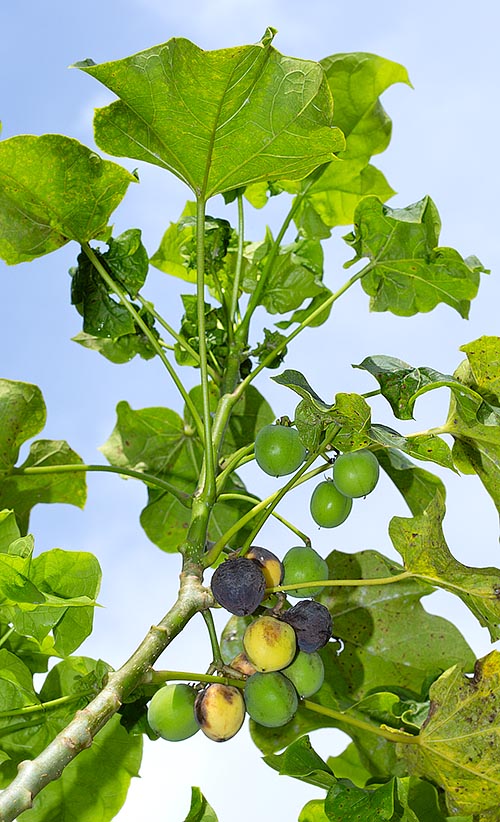
Jatropha Curcas is gaining importance commercially as the demand of nonrenewable fuel sources increases significantly and also Jatropha is an environmentally friendly energy plantation. Plantation of this plant is thought about to be an exceptional fuel alternative and it is also extremely cost-effective compared to other fuels. Recently, Jatropha is dealing with some trouble with bugs and diseases. The pests are classified into two ranges: Pest that affect young plants and Pest that impact grown plants.
Young plant bugs: Cutworm, Scarabeid Beetle, Army worm, Grasshopper.
Agrotis ipsilon: It is commonly understood as Cut worm. This pest impacts the seedlings and young Jatropha plants. If the plant is impacted by the cutworm, the stem gets cut nearer to the soil surface and this will diminished the plant totally.
Control: This pest can be controlled by the larva found around the plants or by mixing the bran, sawdust with insecticides.
Scarabaeid Beetle: This insect damages the root of the young plant. Initially, the larva takes in the natural matters present in the soil and then comes to the root. The larva attack might eliminate the entire plant.
Control: The plant with great resistance power can conquer the insect. For heavy attack, insecticides with components carbosulfan and carbofuran can be used to eliminate the bug.
Army worm: Spodoptera litura existence can be identified by biting in the leaves. The severe infection might totally eliminate the plants.
Control: Insecticides are used to manage the pests.
Grasshopper: This is common insect discovered in numerous plants. Valanga nigricornis and Locusta migratoria commonly attacks the plant. The insect frequently assaults the young plant.
Control: The insecticides used betacyfluthrin, cypermethrin, thiodicarb, MIPC, and fipronil.
Pest observed in fully grown plants:
Pest of Stem: Ostrinia furnacalis, Xyleborus spp.
Ostrinia furnacalis and Xyleborus: This bug harms the Jatropha stem and it is commonly seen in Indonesia. The stem assaulted by this bug normally fall down. The presence can be identified by the larva penetration hole at the stem.
Control: The Insecticide normally used to control this insect is carbofuran.
Pest of leaf: The typical pests observed are leaf caterpillar, Neetle caterpillar, Leaf hopper, Mite, Ear corn caterpillar.
Leaf Caterpillar: This bug can consume all the leaves of the plant simply put duration. The quality and yield of the seeds get decreased due to the heavy attack.
Control: This can be controlled by selecting the old larvae around the surface area and getting rid of the assaulted leaves.
Needle Caterpillar: This caterpillar is covered with spinal columns and produces a burning experience when enabled to exposure to skin as it produces certain chemical compound. Initially the insect crowded in the leaf and after that spread all over the plant when it ages.
Control: Manually, the insect can be killed only by soaking it in water or kerosene. The heavy attack can be controlled by spraying organophosphate insecticides.
Leaf Hopper: This pest is discovered primarily in tropical and subtropical areas. The pest targets the leaf and sucks all the nutrients of the leaf and gets curls at the tip. Later, the entire leaf dry and pass away.
Control: The heavy attack can be controlled by utilizing insecticides like imidachloprid, beta cyfluthrin or carbosulfan.
Mite: Mite also attacks the leaf and makes the entire plant weak. The insect presence can be determined when the leaf become yellow-colored, diminishes, reddens and fall down. The pest can also be spread through fallen leaves.
Control: Some preventive steps can be simulated proper sanitation and burning the fallen leaves. Heavy attack can be treated by spraying insecticides.
Some dreadful insect which attacks flower and fruit are, Stink bug (Nezara viridula)
Chrysocoris javanus, Tip borer caterpillar.
Stink Bug: Sting bug is a major insect which attacks the plant throughout bloom period so the crop yield totally falls down. This insect is seen around the tropical area.
The poisonous enzyme in the plant shrinks the whole plant.
Control: Insecticides suggested for this bug is chlorfluazuron, diflubenzuron, alfamethrin, and lamda cyhalothrin.
Tip borer caterpillar: The bugs typically takes place attacks the plant in flowering season and this insect is seen widely in tropical areas. The female bug laid the eggs on the tender part of the plant and the young larvae feed the young fruits and plant ideas.
Control: Manually, the assaulted seeds are advised to burn. The insecticides like monocrotophos and bensultap are sprayed at the blooming season.